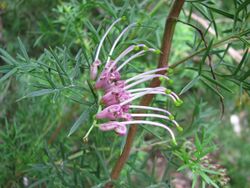Biology:Grevillea rivularis
| Grevillea rivularis | |
|---|---|

| |
| In the Royal Botanic Gardens Victoria | |
| Scientific classification | |
| Kingdom: | Plantae |
| Clade: | Tracheophytes |
| Clade: | Angiosperms |
| Clade: | Eudicots |
| Order: | Proteales |
| Family: | Proteaceae |
| Genus: | Grevillea |
| Species: | G. rivularis
|
| Binomial name | |
| Grevillea rivularis L.A.S.Johnson & McGill.[1]
| |
Grevillea rivularis, commonly known as Carrington Falls grevillea,[2] is a species of flowering plant in the family Proteaceae and is endemic to New South Wales. It is a dense, spreading shrub with divided leaves with more or less linear, sharply-pointed lobes, and clusters of cream-coloured flowers that turn pink or grey as they age.
Description
Grevillea rivularis is a dense, glabrous, spreading shrub that typically grows to a height of 1–2.5 m (3 ft 3 in–8 ft 2 in). Its leaves are divided, 30–60 mm (1.2–2.4 in) long and wide, with 3 to 9 lobes, each lobe with 3 to 5 linear to narrowly triangular lobes 10–30 mm (0.39–1.18 in) long, 1–2.5 mm (0.039–0.098 in) wide and sharply pointed. The edges of the leaves are rolled under, almost enclosing the lower surface apart from the midvein. The flowers are arranged in downturned clusters on one side of a rachis 50–60 mm (2.0–2.4 in) long. The flowers are glabrous, cream-coloured, later pearly pink or grey, the pistil 27–32 mm (1.1–1.3 in) long. Flowering occurs from September to April and the fruit is shaggy hairy follicle 8–10 mm (0.31–0.39 in) long.[2][3][4][5]
Taxonomy
Grevillea rivularis was first formally described in 1975 by Lawrie Johnson and Donald McGillivray in the journal Telopea from specimens collected in 1960 at Carrington Falls by Ernest Francis Constable.[5][6] The specific epithet (rivularis) means "a small stream".[7]
Distribution and habitat
Carrington Falls grevillea grows with other shrubs along creeks and is restricted to Carrington Falls in Budderoo National Park.[4][8]
Conservation status
The species is listed as "endangered" under the Australian Government Environment Protection and Biodiversity Conservation Act 1999[9] and the New South Wales Government Biodiversity Conservation Act 2016. The main threats to the species include its small population size, road and trail management, and inappropriate fire regimes.[8]
References
- ↑ "Grevillea rivularis". Australian Plant Census. https://biodiversity.org.au/nsl/services/apc-format/display/55121.
- ↑ 2.0 2.1 "Grevillea rivularis". Australian Biological Resources Study, Department of Agriculture, Water and the Environment: Canberra. https://profiles.ala.org.au/opus/foa/profile/Grevillea%20rivularis.
- ↑ Wrigley, John W.; Fagg, Murray A. (1991). Banksias, waratahs & grevilleas : and all other plants in the Australian Proteaceae family. North Ryde, NSW, Australia: Angus & Robertson. p. 319. ISBN 0207172773.
- ↑ 4.0 4.1 Makinson, Robert O.. "Grevillea rivularis". Royal Botanic Garden Sydney. https://plantnet.rbgsyd.nsw.gov.au/cgi-bin/NSWfl.pl?page=nswfl&lvl=sp&name=Grevillea~rivularis.
- ↑ 5.0 5.1 McGillivray, Donald (17 July 1975). "Australian Proteaceae: new taxa and notes". Telopea 1 (1): 23. doi:10.7751/telopea19753102.
- ↑ "Grevillea rivularis". APNI. https://id.biodiversity.org.au/instance/apni/457132.
- ↑ Sharr, Francis Aubi; George, Alex (2019). Western Australian Plant Names and Their Meanings (3rd ed.). Kardinya, WA: Four Gables Press. p. 296. ISBN 9780958034180.
- ↑ 8.0 8.1 "Carrington Falls Grevillea - profile". New South Wales Government Office of Environment and Heritage. https://www.environment.nsw.gov.au/threatenedspeciesapp/profile.aspx?id=10378.
- ↑ "Grevillea rivularis — Carrington Falls Grevillea". Australian Government Department of Climate Change, Energy, the Environment and Water. https://www.environment.gov.au/cgi-bin/sprat/public/publicspecies.pl?taxon_id=2953.
Wikidata ☰ Q5608013 entry
 |


